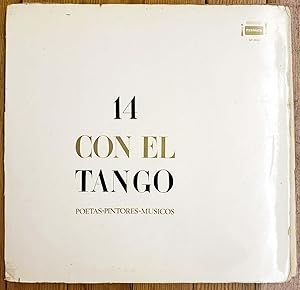Sabato, Ernesto , Fernandez Moreno, Cesar (1 results)
Product Type
- All Product Types
- Books (1)
- Magazines & Periodicals
- Comics
- Sheet Music
- Art, Prints & Posters
- Photographs
- Maps
-
Manuscripts &
Paper Collectibles
Condition
- All Conditions
- New
- Used
Binding
- All Bindings
- Hardcover
- Softcover
Collectible Attributes
- First Edition
- Signed
- Dust Jacket
- Seller-Supplied Images
- Not Printed On Demand
Seller Location
Seller Rating
-
14 con el Tango - Vinyl recording (33 1/3 RPM)
Published by Fermata, 1966
Seller: Chaco 4ever Books, Montevideo, MO, Uruguay
Book
Sin Encuadernar. Condition: Muy bien. Ben Molar in an unprecedented effort, approached the tango fourteen poets and writers chosen among the most important men of letters that the country has. These were the chosen ones: León Benarós, Jorge Luis Borges, Nicolás Cocaro, Cordova Iturburu, Florencio Escardó, Baldomero Fernández Moreno, Alberto Girri, Leopoldo Marechal, Carlos Mastronardi, Manuel Mujica Láinez, Conrado Nalé Roxlo, Ulises Petit de Murat, Ernesto Sabato and César Time. Once obtained the letters of these important men, of the highest level of Argentine literature, sought among the most famous and popular tango musicians. They were: José Basso, Miguel Caló, Juan D'Arienzo, Alfredo De Angelis, Julio De Caro, Enrique Delfino, Lucio Demare, Osvaldo Manzi, Mariano Mores, Sebastián Piana, Astor Piazzolla, Armando Pontier, Hector Stamponi and Aníbal Troilo. The idea was underway, they met periodically and adjusted, retouched, modified, until making the fourteen tangos, which meant the most important nucleation that exists in the world, of famous artists of literature approaching popular music. As a complement and final touch of this magnificent undertaking, he also approached the proposal, fourteen plastic artists of the highest level of Argentine painting: Carlos Alonso, Héctor Basaldúa, Carlos Cañás, Santiago Cogorno, Zdravko Duckelic, Raquel Forner, Vicente Forte , Mario Darío Grandi, Julio Martínez Howard, Onofrio Pacenza, Leopoldo Presas, Luis Seoane, Raul Soldi and Carlos Torrallardona. The result of this fruitful task were fourteen titles: "Alejandra", by Ernesto Sabato and Aníbal Troilo "Bailate un tango Ricardo", by Ulises Petit de Murat and Juan D'Arienzo "Como nadie", by Manuel Mujica Láinez and Lucio Demare "Elegy", by Alberto Girri and Osvaldo Manzi "In which corner I find you Buenos Aires", by Florencio Escardó and Héctor Stamponi "The butterfly and death", by Leopoldo Marechal and Armando Pontier "Marisol", by Córdova Iturburu and Sebastián Piana "Milonga de Albornoz", by Jorge Luis Borges and José Basso "Nadie puede", by César Tiempo and Enrique Delfino "Oro y gris", by León Benarós and Mariano Mores "Sabor de Buenos Aires", by Carlos Mastronardi and Miguel Caló "Seventy balconies and no flowers", by Baldomero Fernández Moreno and Astor Piazzolla "Tango for Juan Soldado", by Conrado Nalé Roxlo and Alfredo De Angelis "A whistle in the pocket", by Nicolás Cocaro and Julio De Caro. With these forty-two men, fourteen in each of these pillars: music, poetry and plastic, Ben Molar made an album in which goes a long-playing album, where we find fourteen themes and two pages containing the thought about the tango of all the artists, with their respective autographs. There are also the plates that reproduce each of the fourteen paintings that interpret each of the creations pictorially. The different ranges of tango have been included on the album: the tango canción, the tango milonga, the tango salón, the avant-garde tango and the lunfardo tango, that is to say, many of the variants that our citizen music has. It is clear that also the focus of each composition varies according to the different styles of poets and musicians, which increases the richness of this cultural material. With respect to the fourteen paintings that interpret the subjects pictorially, they were made by a group of plastics that also make a very complete sample of Argentine painting. The first time the paintings were exhibited was used to expose them, fourteen stained-glass windows to the street, of fourteen prestigious commercial premises, in fourteen blocks of Santa Fe Avenue (one of the most elegant avenues of Buenos Aires) and then in seven stained glass windows the street of an important Florida street trade.


